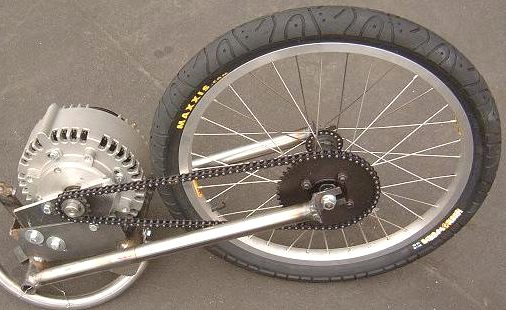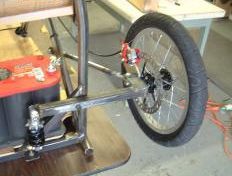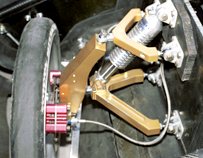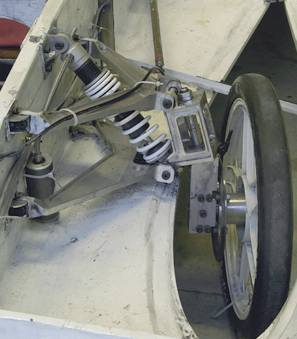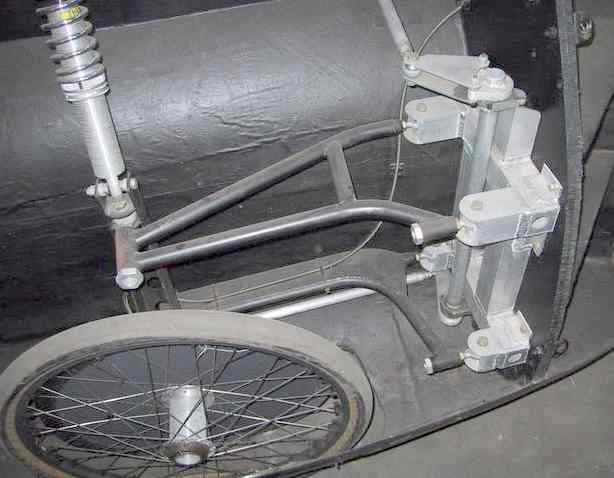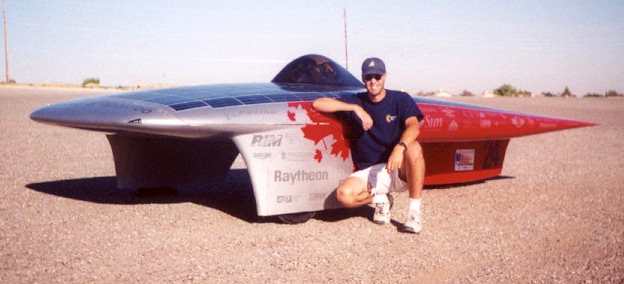|
|||||||||
|
As part of the chassis design, you will of course have worked out what type of suspension to use. It may have come about the other way. You may have chosen your suspension, positioned your driver and motor, then joined up all the bits with a frame. There are indeed many ways to achieve a design. I sometimes start with the aerodynamics, get a body shape, then try and fit in the best suspension, motors and batteries, etc, around the driver.
Whichever way you go about designing your solar car, the mechanical systems should be simple in concept, but designed to minimize friction and weight while maintaining the strength needed to handle the various road conditions. You should take a good look at existing state of the art. You will learn a lot from this research and then you can apply your own ideas. Lightweight metals like titanium and composites are commonly used to maximize the strength-to-weight ratio needed to build efficient components. The mechanical systems include the suspension, brakes, steering, wheels, and tires. Regulations from most events set minimum standards that mechanical components must meet, but as mentioned elsewhere there are no standard designs used in solar cars.
Steering & Suspension
Brakes
Motor driving single rear wheel
Solar cars typically have three or four wheels, where the rules require at least three, or the vehicle falls into a cycle category. The common three wheel configuration is two front wheels and one rear wheel (usually the driven wheel). Four wheel vehicles are sometimes configured like a conventional vehicle (with one of the rear wheels driven). Other four wheel vehicles have the two rear wheels close together near the center (similar to the common three wheel configuration). In theory, three should be more efficient, since there are less moving parts and rolling resistance may be lower.
A wide variety of suspensions are implemented on solar cars. This is partly due to the fact that the body and chassis designs are so different between cars. The most common type of front suspension used in solar cars is the double A-arm suspension, similar to those used on conventional vehicles. Typically, trailing arm suspensions similar to those found on motorcycles are utilized in the rear. Teams design their suspension components to move freely and smoothly for maximum efficiency. The design must also be adjustable so as to maintain proper alignment and functionality.
Disc brakes cycle parts
One of the great things about solar cars, is that you have a free hand to let your imagination roam. That is one of the reasons for the incredible diversity, although I think you may agree, the monocoque designs are beginning to look a bit samey.
Safety should be high priority for any designer. For this reason, solar cars must meet stringent braking performance standards and every solar car is required to have two independent braking systems, much like the dual braking systems on production cars. Disk brakes are most commonly used in solar cars because of their adjustability and good braking power. Some teams use mechanically actuated brakes while others use hydraulic. Mechanical brakes tend to be smaller and lighter than hydraulic, but don't offer as much brake force and require constant tuning. To maximize efficiency, the brakes are designed to move freely by eliminating brake drag, which is caused by brake pads rubbing against the brake surface.
Double wishbone suspension and steering
The steering systems within a solar car, much like suspensions, vary greatly. The teams must meet turning radius and handling requirements, but are free to use any design. The major design factors for steering are reliability and efficient performance. The steering system is designed with precise steering alignment because even small misalignments can cause significant losses and increase tire wear. Many teams now use long uprights mating onto high mounted wishbones. This reduces the thickness of the wheel spats or fairings, hence lowers drag. The object of employing suspension is obviously to cushion the vehicles passage. It should be soft enough to protect the car and solar array from unnecessary jolts and firm enough to provide a stable ride. A good suspension will also ensure the wheels stay in contact with the road surface, by controlling bounce and re-bound. A spring allows movement and a shock absorber, or damper, prevents oscillation.
Tires
In early racing events, bicycle wheels and tires were commonly used because of their lightweight and low rolling resistance (minimal friction). These wheels and tires were generally overloaded when supporting the weight of a solar car, which effected the performance and safety of the vehicle. Event Regulations do not allow overloaded tires and wheels. Fortunately, the popularity of solar car raycing has prompted some tire manufacturers to construct tires designed for solar cars. Most teams are taking advantage of these low rolling resistant, lightweight wheels and tires that increase both safety and performance.
Leading arm suspension and steering
If you get it all right you often achieve a nice shape
A taste for adventure Solar Cola - the healthier alternative.
|
|||||||||
|
EDUCATION | SOLAR CAR RACING TEAMS | SOLAR CAR RACING EVENTS | FILMS | MUSIC |
|||||||||
|
The
content of this website is copyright © and design copyright 1991 and
2019 Electrick Publications. All rights reserved. The bluebird
logo |
